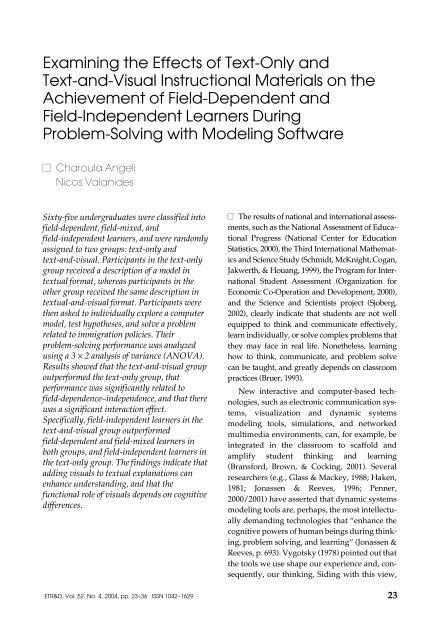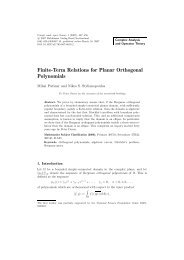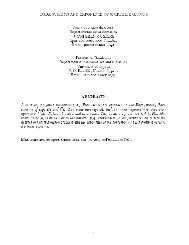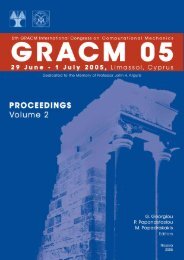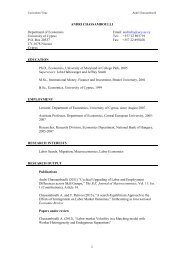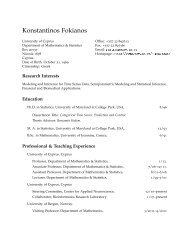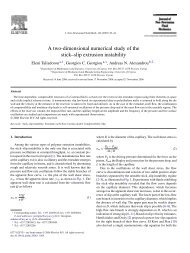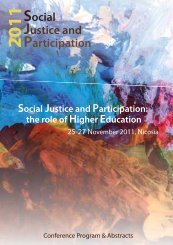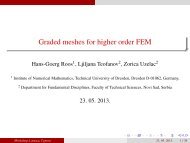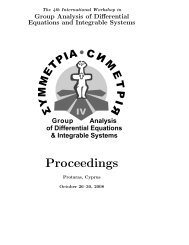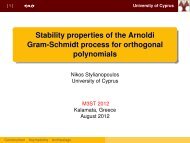Examining the Effects of Text-Only and Text-and-Visual Instructional ...
Examining the Effects of Text-Only and Text-and-Visual Instructional ...
Examining the Effects of Text-Only and Text-and-Visual Instructional ...
You also want an ePaper? Increase the reach of your titles
YUMPU automatically turns print PDFs into web optimized ePapers that Google loves.
<strong>Examining</strong> <strong>the</strong> <strong>Effects</strong> <strong>of</strong> <strong>Text</strong>-<strong>Only</strong> <strong>and</strong><br />
<strong>Text</strong>-<strong>and</strong>-<strong>Visual</strong> <strong>Instructional</strong> Materials on <strong>the</strong><br />
Achievement <strong>of</strong> Field-Dependent <strong>and</strong><br />
Field-Independent Learners During<br />
Problem-Solving with Modeling S<strong>of</strong>tware<br />
Charoula Angeli<br />
Nicos Valanides<br />
Sixty-five undergraduates were classified into<br />
field-dependent, field-mixed, <strong>and</strong><br />
field-independent learners, <strong>and</strong> were r<strong>and</strong>omly<br />
assigned to two groups: text-only <strong>and</strong><br />
text-<strong>and</strong>-visual. Participants in <strong>the</strong> text-only<br />
group received a description <strong>of</strong> a model in<br />
textual format, whereas participants in <strong>the</strong><br />
o<strong>the</strong>r group received <strong>the</strong> same description in<br />
textual-<strong>and</strong>-visual format. Participants were<br />
<strong>the</strong>n asked to individually explore a computer<br />
model, test hypo<strong>the</strong>ses, <strong>and</strong> solve a problem<br />
related to immigration policies. Their<br />
problem-solving performance was analyzed<br />
using a 3 × 2 analysis <strong>of</strong> variance (ANOVA).<br />
Results showed that <strong>the</strong> text-<strong>and</strong>-visual group<br />
outperformed <strong>the</strong> text-only group, that<br />
performance was significantly related to<br />
field-dependence–independence, <strong>and</strong> that <strong>the</strong>re<br />
was a significant interaction effect.<br />
Specifically, field-independent learners in <strong>the</strong><br />
text-<strong>and</strong>-visual group outperformed<br />
field-dependent <strong>and</strong> field-mixed learners in<br />
both groups, <strong>and</strong> field-independent learners in<br />
<strong>the</strong> text-only group. The findings indicate that<br />
adding visuals to textual explanations can<br />
enhance underst<strong>and</strong>ing, <strong>and</strong> that <strong>the</strong><br />
functional role <strong>of</strong> visuals depends on cognitive<br />
differences.<br />
The results <strong>of</strong> national <strong>and</strong> international assessments,<br />
such as <strong>the</strong> National Assessment <strong>of</strong> Educational<br />
Progress (National Center for Education<br />
Statistics, 2000), <strong>the</strong> Third International Ma<strong>the</strong>matics<br />
<strong>and</strong> Science Study (Schmidt, McKnight, Cogan,<br />
Jakwerth, & Houang, 1999), <strong>the</strong> Program for International<br />
Student Assessment (Organization for<br />
Economic Co-Operation <strong>and</strong> Development, 2000),<br />
<strong>and</strong> <strong>the</strong> Science <strong>and</strong> Scientists project (Sjoberg,<br />
2002), clearly indicate that students are not well<br />
equipped to think <strong>and</strong> communicate effectively,<br />
learn individually, or solve complex problems that<br />
<strong>the</strong>y may face in real life. None<strong>the</strong>less, learning<br />
how to think, communicate, <strong>and</strong> problem solve<br />
can be taught, <strong>and</strong> greatly depends on classroom<br />
practices (Bruer, 1993).<br />
New interactive <strong>and</strong> computer-based technologies,<br />
such as electronic communication systems,<br />
visualization <strong>and</strong> dynamic systems<br />
modeling tools, simulations, <strong>and</strong> networked<br />
multimedia environments, can, for example, be<br />
integrated in <strong>the</strong> classroom to scaffold <strong>and</strong><br />
amplify student thinking <strong>and</strong> learning<br />
(Bransford, Brown, & Cocking, 2001). Several<br />
researchers (e.g., Glass & Mackey, 1988; Haken,<br />
1981; Jonassen & Reeves, 1996; Penner,<br />
2000/2001) have asserted that dynamic systems<br />
modeling tools are, perhaps, <strong>the</strong> most intellectually<br />
dem<strong>and</strong>ing technologies that “enhance <strong>the</strong><br />
cognitive powers <strong>of</strong> human beings during thinking,<br />
problem solving, <strong>and</strong> learning” (Jonassen &<br />
Reeves, p. 693). Vygotsky (1978) pointed out that<br />
<strong>the</strong> tools we use shape our experience <strong>and</strong>, consequently,<br />
our thinking. Siding with this view,<br />
ETR&D, Vol. 52, No. 4, 2004, pp. 23–36 ISSN 1042–1629 23
24 ETR&D, Vol. 52, No. 4<br />
Brown, Collins, <strong>and</strong> Duguid (1989) stated that<br />
knowledge is not objective but contextually situated,<br />
<strong>and</strong> is fundamentally influenced by <strong>the</strong><br />
activity, context, <strong>and</strong> culture in which it is used.<br />
A central implication <strong>of</strong> this situated view <strong>of</strong><br />
learning for <strong>the</strong> design <strong>of</strong> technology-enhanced<br />
learning environments is that knowledge building<br />
<strong>and</strong> underst<strong>and</strong>ing can be viewed as <strong>the</strong><br />
appropriation <strong>of</strong> tools allowing learners to build<br />
on <strong>the</strong>ir initial conceptions, while being engaged<br />
in a problem-solving activity (Jonassen & L<strong>and</strong>,<br />
2000; L<strong>and</strong> & Hannafin, 1997; Rog<strong>of</strong>f, 1990).<br />
In view <strong>of</strong> recognizing <strong>the</strong> importance <strong>of</strong><br />
underst<strong>and</strong>ing how computer-modeling tools<br />
assist <strong>the</strong> learning process, it seems useful to<br />
study <strong>the</strong> effects that different instructional<br />
materials, textual or visual, may have on learner<br />
performance during problem solving with <strong>the</strong>se<br />
tools. Undoubtedly, <strong>the</strong> phrase “one picture is<br />
worth a thous<strong>and</strong> words is a core idea <strong>of</strong> visualization<br />
<strong>and</strong> modeling” (Kali, 2002, p. 305) is true,<br />
because appropriate visualizations can improve<br />
learner perception <strong>of</strong> <strong>the</strong> objects or <strong>the</strong> ideas <strong>the</strong><br />
pictures represent. Never<strong>the</strong>lesss, learning from<br />
ei<strong>the</strong>r textual or visual information is also<br />
directly associated with representational preferences<br />
<strong>and</strong> cognitive controls or cognitive styles.<br />
As Salomon (1994) argued, “It would be impossible<br />
to consider <strong>the</strong> interactions <strong>of</strong> media, cognition,<br />
<strong>and</strong> learning without taking into account<br />
<strong>the</strong> variety <strong>of</strong> ways in which individuals construct<br />
meaning <strong>and</strong> acquire knowledge” (p.<br />
xxii). Chinien <strong>and</strong> Boutin (1992/1993) also<br />
asserted that individual differences become<br />
important for researchers to consider when<br />
studying <strong>the</strong> performance <strong>of</strong> individuals interacting<br />
with technology to accomplish a task.<br />
Individual differences may refer to differences<br />
in cognitive ability, or cognitive control 1 (style)<br />
representing patterns <strong>of</strong> thinking that regulate<br />
<strong>and</strong> control <strong>the</strong> way individuals process <strong>and</strong><br />
reason about information (Jonassen &<br />
Grabowski, 1993).<br />
A well-documented <strong>and</strong> popular source <strong>of</strong><br />
cognitive difference is <strong>the</strong> construct <strong>of</strong> fielddependence–independence<br />
(FD-I) (Dillon &<br />
1. The words cognitive control <strong>and</strong> cognitive style are used<br />
interchangeably in this article, as synonyms, without<br />
differentiating between <strong>the</strong>m.<br />
Gabbard, 1998). FD-I is generally considered to<br />
represent differences in learner visual perception,<br />
or comprehension <strong>of</strong> information, due to<br />
<strong>the</strong> effects <strong>of</strong> <strong>the</strong> encompassing field, or instructional<br />
context, related to <strong>the</strong> complexity <strong>of</strong> <strong>the</strong><br />
problem-solving task <strong>and</strong> <strong>the</strong> instructional<br />
materials (Morgan, 1997; Reiff, 1996; Witkin,<br />
Moore, Goodenough, & Cox, 1977). FD-I<br />
describes learners along a continuum such that<br />
individuals at one end are considered to be fielddependent<br />
(FD), <strong>and</strong> individuals at <strong>the</strong> o<strong>the</strong>r<br />
end field-independent (FI). Individuals who fall<br />
in <strong>the</strong> middle <strong>of</strong> <strong>the</strong> continuum are characterized<br />
as field-mixed (FM) (Liu & Reed, 1994).<br />
The key difference between FD <strong>and</strong> FI learners<br />
is visual perceptiveness. FD learners who are<br />
asked to identify a simple geometric figure that<br />
is embedded in a complex figure will take longer<br />
to identify <strong>the</strong> simple figure than FI learners, or<br />
FD learners may not be able to do it at all. FD<br />
learners are, thus, not visually perceptive <strong>and</strong><br />
have more difficulty in abstracting relevant<br />
information from visual (or even textual)<br />
instructional materials supporting more difficult<br />
learning tasks (Canelos, Taylor, & Gates, 1980;<br />
Liu & Reed, 1994; Lyons-Lawrence, 1994). Obviously,<br />
FD learners are more influenced by <strong>the</strong><br />
prevailing field, <strong>and</strong>, thus, <strong>of</strong>ten fail to isolate<br />
target information, because o<strong>the</strong>r information<br />
tends to camouflage what <strong>the</strong>y are looking for<br />
(Jonassen & Grabowski, 1993).<br />
The characteristics <strong>of</strong> FD <strong>and</strong> FI learners<br />
appear to have important implications for<br />
instructional design (Chinien & Boutin,<br />
1992/1993). FI learners are more successful in<br />
isolating target information from a complex<br />
whole, <strong>and</strong> can process information with more<br />
accurate performance on visual search tasks,<br />
analyze ideas into <strong>the</strong>ir constituent parts, <strong>and</strong><br />
reorganize ideas into new configurations (Davis,<br />
1991; Goodenough & Karp, 1961; Snowman &<br />
Biehler, 2003). On <strong>the</strong> contrary, FD learners are<br />
global, factually oriented, <strong>and</strong> traditional in<br />
<strong>the</strong>ir thinking (Lambert, 1981; Tannenbaum,<br />
1982). The ramifications, however, <strong>of</strong> FD-I on <strong>the</strong><br />
performance <strong>of</strong> learners interacting with computers<br />
to accomplish a task are not well established,<br />
<strong>and</strong> <strong>the</strong> results <strong>of</strong> research studies are still<br />
inconclusive (Davis, 1991; Dillon & Gabbard,<br />
1998), <strong>and</strong>, at times, contradictory.
EFFECTS OF INSTRUCTIONAL MATERIALS ON LEARNER ACHIEVEMENT 25<br />
2. In <strong>the</strong> context <strong>of</strong> this study, cognitive coupling is <strong>the</strong><br />
relationship between <strong>the</strong> cognitive characteristics <strong>of</strong> <strong>the</strong><br />
learner <strong>and</strong> <strong>the</strong> corresponding cognitive dem<strong>and</strong>s <strong>of</strong> <strong>the</strong><br />
employed textual <strong>and</strong> visual materials.<br />
For example, in a study undertaken by<br />
Zehavi (1995), <strong>the</strong> results showed that FD students<br />
could also benefit from computer-based<br />
instruction when <strong>the</strong> s<strong>of</strong>tware was designed<br />
appropriately. Similarly, Liu <strong>and</strong> Reed (1994)<br />
studied <strong>the</strong> extent to which field type could have<br />
an effect on learner achievement in learning<br />
English using a hypermedia instructional system<br />
that was appropriately designed to<br />
accommodate preferences <strong>of</strong> different field<br />
types. It was found that FD <strong>and</strong> FI learners benefited<br />
equally from <strong>the</strong> hypermedia instructional<br />
system. On <strong>the</strong> o<strong>the</strong>r h<strong>and</strong>, <strong>the</strong>re is<br />
research evidence supporting <strong>the</strong> idea that field<br />
type does have bearing on learning from<br />
hypermedia. For example, Weller, Repman, <strong>and</strong><br />
Rooze (1994) found that <strong>the</strong> effectiveness <strong>of</strong><br />
hypermedia is correlated with cognitive control.<br />
In an experiment with four treatments that varied<br />
according to <strong>the</strong> presence <strong>of</strong> advance organizers<br />
<strong>and</strong> navigational cues, FI learners<br />
outperformed FD learners across all treatments.<br />
Lyons-Lawrence (1994) also concluded in her<br />
study that FD students are not well suited to<br />
computerized instruction. Thus, it is still not<br />
clear whe<strong>the</strong>r <strong>the</strong> medium <strong>of</strong> instruction has an<br />
effect on <strong>the</strong> performances <strong>of</strong> FI <strong>and</strong> FD learners<br />
or whe<strong>the</strong>r FI learners will always outperform<br />
FD learners despite <strong>the</strong> medium <strong>of</strong> instruction<br />
(Davis, 1991).<br />
Given <strong>the</strong> equivocal results, more research<br />
effort should be directed toward examining <strong>the</strong><br />
extent to which dynamic modeling tools are better<br />
fitted to one type <strong>of</strong> learner or ano<strong>the</strong>r.<br />
Undoubtedly, <strong>the</strong> consideration <strong>of</strong> individual<br />
differences in human-computer interaction<br />
studies may provide not only guidance on how<br />
computer tools can best be targeted at specific<br />
types <strong>of</strong> learners in <strong>the</strong> classroom learning environment,<br />
but also clear indications <strong>of</strong> how optimal<br />
“cognitive coupling” 2 <strong>and</strong> better<br />
performance <strong>of</strong> “joint cognitive systems,” can be<br />
achieved (Dalal & Kasper, 1994; Dillon & Gabbard,<br />
1998).<br />
On <strong>the</strong> basis <strong>of</strong> <strong>the</strong> above rationale, <strong>the</strong> present<br />
study was designed to investigate whe<strong>the</strong>r<br />
different instructional materials, using only textual<br />
or textual-<strong>and</strong>-visual representations, differentially<br />
affect learner achievement during<br />
problem solving with modeling s<strong>of</strong>tware,<br />
depending on learner cognitive control (i.e., FD-<br />
I). More specifically, answers to <strong>the</strong> following<br />
three questions were sought:<br />
1. Do textual-only (T-O) <strong>and</strong> textual-<strong>and</strong>-visual<br />
(T-V) instructional materials differentially<br />
affect learner achievement during problem<br />
solving with modeling s<strong>of</strong>tware?<br />
2. Does problem-solving performance with<br />
modeling s<strong>of</strong>tware relate to learner FD-I?<br />
3. Do T-O <strong>and</strong> T-V instructional materials interact<br />
with learner FD-I to differentially affect<br />
<strong>the</strong>ir achievement during problem solving<br />
with modeling s<strong>of</strong>tware?<br />
Participants<br />
METHODOLOGY<br />
Research participants were recruited from <strong>the</strong><br />
2001–2002 freshman class <strong>of</strong> teacher-education<br />
students at a university. Specifically, <strong>of</strong> <strong>the</strong> 165<br />
first-year teacher-education students, who at <strong>the</strong><br />
time were enrolled in four different sections <strong>of</strong><br />
an undergraduate-level technology course, 157<br />
<strong>of</strong> <strong>the</strong>m volunteered to participate in <strong>the</strong> study.<br />
This task was one <strong>of</strong> three possible assignments<br />
from which students could choose to fulfill <strong>the</strong><br />
course requirements.<br />
Initially, prospective participants were asked<br />
if <strong>the</strong>y had any prior knowledge relating to<br />
ei<strong>the</strong>r dynamic systems modeling s<strong>of</strong>tware or<br />
immigration policies. None <strong>of</strong> <strong>the</strong> students<br />
reported any familiarity with immigration policies.<br />
However, two students, a male <strong>and</strong> a<br />
female, who stated that <strong>the</strong>y had some prior<br />
knowledge with modeling s<strong>of</strong>tware, were not<br />
allowed to participate in <strong>the</strong> study. Before forming<br />
<strong>the</strong> final sample <strong>of</strong> <strong>the</strong> study, prospective<br />
participants were also administered <strong>the</strong> Hidden<br />
Figures Test (HFT) (French, Ekstrom, & Price,<br />
1963). Based on <strong>the</strong>ir HFT scores, most <strong>of</strong> <strong>the</strong>m<br />
were classified as ei<strong>the</strong>r FD (55) or FM (79), <strong>and</strong><br />
only 23 as FI, learners. Therefore, we included<br />
all 23 students who were identified as FI, <strong>and</strong>
26 ETR&D, Vol. 52, No. 4<br />
r<strong>and</strong>omly selected 24 FM <strong>and</strong> 24 FD students, in<br />
an attempt to maximize <strong>the</strong> final sample <strong>of</strong> <strong>the</strong><br />
study without any serious threat to <strong>the</strong> validity<br />
<strong>of</strong> <strong>the</strong> results. Of <strong>the</strong> 71 students who participated<br />
in <strong>the</strong> study, data obtained from 6 (2 males<br />
<strong>and</strong> 4 females) were used to pilot test <strong>the</strong><br />
research materials <strong>and</strong> procedures. Thus, only<br />
<strong>the</strong> data from <strong>the</strong> remaining 65 participants (22<br />
FD, 22 FM, <strong>and</strong> 21 FI learners) were used in <strong>the</strong><br />
main study, <strong>and</strong> <strong>the</strong> final sample was much<br />
smaller than <strong>the</strong> initial pool <strong>of</strong> voluntary participants.<br />
Of <strong>the</strong> 65 participants, 53 were female <strong>and</strong><br />
12 were male, to match <strong>the</strong> ratio <strong>of</strong> female to<br />
male in <strong>the</strong> initial pool <strong>of</strong> 165 teacher-education<br />
students.<br />
Students from each group <strong>of</strong> learners (FD,<br />
FM, <strong>and</strong> FI) were r<strong>and</strong>omly assigned into two<br />
groups, namely, text-only (T-O) <strong>and</strong> text-<strong>and</strong>visual<br />
(T-V), that differed in <strong>the</strong> type <strong>of</strong> materials<br />
<strong>the</strong>y received in order to solve a complex<br />
task. The T-O group consisted <strong>of</strong> 11 students<br />
from each group <strong>of</strong> FD, FM, <strong>and</strong> FI learners,<br />
whereas <strong>the</strong> T-V group had 11 FD <strong>and</strong> 11 FM<br />
learners, but only 10 FI learners.<br />
Instruments<br />
The HFT, which is one <strong>of</strong> <strong>the</strong> 72 tests in <strong>the</strong> kit <strong>of</strong><br />
factor referenced cognitive tests, was used to<br />
determine participant field type (French et al.,<br />
1963). The HFT has 32 questions, <strong>and</strong> is ei<strong>the</strong>r<br />
self- or group administered. It consists <strong>of</strong> two<br />
separate parts; 12 min are allowed for answering<br />
each part. The items require individuals to identify<br />
or determine which one <strong>of</strong> five simple figures<br />
is embedded in a more complex pattern.<br />
One point is assigned to each correct answer to a<br />
test item; <strong>the</strong> total test score ranges from 0–32.<br />
The HFT has been used extensively in research,<br />
is reliable, <strong>and</strong> is highly correlated (r = .67 to .88)<br />
to <strong>the</strong> Group Embedded Figures Test (Witkin,<br />
Oltman, Raskin, & Karp, 1971).<br />
For <strong>the</strong> purpose <strong>of</strong> this study, <strong>the</strong> HFT was<br />
administered to six groups <strong>of</strong> elementary-education<br />
students, totaling 157 people. Their average<br />
performance was 14.43 (SD = 5.42). Those who<br />
scored 10 or lower were classified as FD, those<br />
who scored from 11 to 21 as FM, <strong>and</strong> those who<br />
scored 22 or higher as FI. The cut-<strong>of</strong>f scores <strong>and</strong><br />
<strong>the</strong> resulting classification scheme were based<br />
on <strong>the</strong> rationale that <strong>the</strong> FD-I construct describes<br />
learners along a continuum (Liu & Reed, 1994),<br />
<strong>and</strong>, consequently, studying <strong>the</strong> performance <strong>of</strong><br />
those who fall in <strong>the</strong> two extreme ends <strong>of</strong> <strong>the</strong><br />
continuum <strong>and</strong> those who fall in <strong>the</strong> middle<br />
range would reveal any differences associated<br />
with <strong>the</strong> construct. The results <strong>of</strong> <strong>the</strong> HFT indicated<br />
that only 23 students were FI, whereas <strong>the</strong><br />
rest were ei<strong>the</strong>r FD (55) or FM (79), <strong>and</strong>, thus, <strong>the</strong><br />
final sample <strong>of</strong> <strong>the</strong> study was smaller than <strong>the</strong><br />
initial pool <strong>of</strong> volunteers.<br />
Description <strong>of</strong> Modeling S<strong>of</strong>tware<br />
Model-It® is a dynamic systems modeling tool<br />
that has been used with middle school, high<br />
school, <strong>and</strong> college students with notable success<br />
(Metcalf, Krajcik, & Soloway, 2000; Stratford,<br />
Krajcik, & Soloway, 1998). Model-It was<br />
used in this study to create a model about immigration<br />
dynamics, as shown in Figure 1.<br />
A model usually consists <strong>of</strong> entities, factors,<br />
<strong>and</strong> relationships between factors. In <strong>the</strong> model<br />
in Figure 1, <strong>the</strong>re are two entities, Mexico <strong>and</strong><br />
<strong>the</strong> United States. Each entity has several factors<br />
associated with it. Factors represent measurable<br />
or calculable characteristics <strong>of</strong> <strong>the</strong> entities, such<br />
as population, labor force, immigration flow,<br />
immigration rate, <strong>and</strong> jobs. Finally, factors are<br />
designated as causal or affected depending on<br />
<strong>the</strong> direction <strong>of</strong> <strong>the</strong> relationship between <strong>the</strong>m.<br />
For example, as shown in Figure 2, Mexican<br />
labor force is <strong>the</strong> affected factor <strong>and</strong> Mexican<br />
population is <strong>the</strong> causal factor, because any<br />
increase in <strong>the</strong> Mexican population will cause an<br />
increase in <strong>the</strong> Mexican labor force.<br />
After creating a model, <strong>the</strong> user may run it.<br />
When a model is run, a timer, as shown in Figure<br />
3, counts arbitrarily sized time steps, which<br />
may represent a minute, an hour, or whatever<br />
time interval <strong>the</strong> user may conceptualize. The<br />
user can also test a model using graphical tools.<br />
One tool, <strong>the</strong> meter (see Figure 3), displays <strong>the</strong><br />
value <strong>of</strong> <strong>the</strong> factor at <strong>the</strong> current time step. If a<br />
factor is considered to be independent, its value<br />
can be adjusted while <strong>the</strong> model is running.<br />
Thus, <strong>the</strong> user may test a model at run time <strong>and</strong><br />
observe how it changes dynamically. As shown
EFFECTS OF INSTRUCTIONAL MATERIALS ON LEARNER ACHIEVEMENT 27<br />
Figure 1<br />
A model on immigration dynamics.<br />
in Figure 3, <strong>the</strong>re is also ano<strong>the</strong>r tool, <strong>the</strong> simulation<br />
graph, which presents a line graph displaying<br />
how factors change over a series <strong>of</strong> time<br />
steps.<br />
Model-It supports relationships (Jackson,<br />
Stratford, Krajcik, & Soloway, 1996) that can<br />
model immediate effects in <strong>the</strong> value <strong>of</strong> <strong>the</strong><br />
affected factor due to a change in <strong>the</strong> value <strong>of</strong> <strong>the</strong><br />
causal factor that preceded it. As shown in Figure<br />
2, Model-It also supports a qualitative, verbal<br />
description <strong>of</strong> relationships, because changes<br />
in a relationship may be defined in terms <strong>of</strong> two<br />
orientations (i.e., increases or decreases) <strong>and</strong> different<br />
variations (i.e., about <strong>the</strong> same, a lot, a little,<br />
more <strong>and</strong> more, less <strong>and</strong> less).<br />
<strong>Instructional</strong> Task<br />
Participants had to individually explore <strong>the</strong><br />
model for solving a problem about immigration<br />
policy, shown in Figure 1. In order to solve <strong>the</strong><br />
problem, students had to underst<strong>and</strong> <strong>the</strong> underlying<br />
structure <strong>of</strong> <strong>the</strong> model, that is, its entities,<br />
<strong>the</strong> related factors, <strong>and</strong> <strong>the</strong> relationships among<br />
<strong>the</strong>m. Thereafter, <strong>the</strong>y were to form hypo<strong>the</strong>ses,<br />
test <strong>the</strong>m, evaluate <strong>the</strong>ir consequences, <strong>and</strong><br />
decide on <strong>the</strong> optimal solution to <strong>the</strong> problem.<br />
The model presented <strong>the</strong> immigration situation<br />
created by a gap in unemployment rates<br />
between <strong>the</strong> United States <strong>and</strong> Mexico, <strong>and</strong><br />
opportunities for employment in <strong>the</strong> United<br />
States. It showed cause-<strong>and</strong>-effect relationships<br />
between several factors affecting <strong>the</strong> unemployment<br />
rate in each country, such as population,<br />
labor force, <strong>and</strong> job export. For example, <strong>the</strong><br />
model showed how an increase in Mexican population<br />
would cause an increase in <strong>the</strong> Mexican<br />
labor force, <strong>and</strong>, consequently, an increase in <strong>the</strong><br />
Mexican unemployment rate. The model also<br />
showed how an increase in <strong>the</strong> Mexican unemployment<br />
rate would cause an increase in <strong>the</strong><br />
movement <strong>of</strong> Mexicans to <strong>the</strong> United States, <strong>and</strong><br />
how this increase in immigration flow to <strong>the</strong><br />
United States would finally cause an increase in<br />
<strong>the</strong> unemployment rate <strong>of</strong> <strong>the</strong> United States.<br />
Participants were given four possible policies
28 ETR&D, Vol. 52, No. 4<br />
Figure 2<br />
Defining relationships between factors.<br />
Figure 3<br />
Running a model.
EFFECTS OF INSTRUCTIONAL MATERIALS ON LEARNER ACHIEVEMENT 29<br />
to explore in Model-It: (a) Open Border, (b)<br />
Closed Border, (c) Job Export, <strong>and</strong> (d) Immigration.<br />
An open border policy encourages <strong>the</strong><br />
immigration <strong>of</strong> Mexican people to <strong>the</strong> United<br />
States, <strong>and</strong> allows <strong>the</strong> free movement <strong>of</strong> businesses<br />
<strong>and</strong> jobs from <strong>the</strong> United States to Mexico.<br />
A closed border policy discourages <strong>the</strong><br />
immigration <strong>of</strong> Mexicans to <strong>the</strong> United States<br />
<strong>and</strong> <strong>the</strong> movement <strong>of</strong> industries <strong>and</strong> jobs from<br />
<strong>the</strong> United States to Mexico. A job export policy<br />
creates disincentives for American businesses in<br />
order to discourage <strong>the</strong>ir movement from <strong>the</strong><br />
United States to Mexico. In addition, this policy<br />
implements trade barriers, so that Mexican<br />
goods become more expensive to sell in <strong>the</strong><br />
United States. Lastly, an immigration policy<br />
does not allow <strong>the</strong> immigration <strong>of</strong> Mexicans to<br />
<strong>the</strong> United States, but it takes no action about <strong>the</strong><br />
movement <strong>of</strong> businesses <strong>and</strong> jobs from <strong>the</strong><br />
United States to Mexico. Students were asked to<br />
form hypo<strong>the</strong>ses based on <strong>the</strong>se policies, <strong>and</strong><br />
test <strong>the</strong>m using Model-It. Then, <strong>the</strong>y were asked<br />
to evaluate <strong>the</strong> results, <strong>and</strong> propose <strong>the</strong> policy<br />
that should be adopted for <strong>the</strong> purpose <strong>of</strong> regulating,<br />
as optimally as possible, <strong>the</strong> situation at<br />
<strong>the</strong> Mexico–United States border.<br />
Materials<br />
Two sets <strong>of</strong> materials were used. Both sets<br />
instructed <strong>the</strong> participants to assume <strong>the</strong> role <strong>of</strong><br />
a chief immigration <strong>of</strong>ficer responsible for<br />
studying all matters concerning <strong>the</strong> Mexican-<br />
United States immigration problem. The materials<br />
explained that a team <strong>of</strong> research staff<br />
prepared <strong>the</strong> model in Figure 1 to help <strong>the</strong> chief<br />
immigration <strong>of</strong>ficer better underst<strong>and</strong> <strong>the</strong><br />
dynamics <strong>of</strong> immigration policy. Both sets also<br />
included Figure 1, followed by a description <strong>and</strong><br />
instructions for opening <strong>the</strong> file with <strong>the</strong> model<br />
in Model-It. Lastly, <strong>the</strong> four immigration policies<br />
were explained, <strong>and</strong> students in both<br />
groups were asked to examine <strong>the</strong> model in<br />
Model-It, conduct experiments, <strong>and</strong> write in <strong>the</strong><br />
space provided which policy <strong>the</strong>y would<br />
assume to better manage <strong>the</strong> situation at <strong>the</strong><br />
Mexico–United States border.<br />
In <strong>the</strong> T-O set, <strong>the</strong> model was described only<br />
in narrative (textual) form. In particular, <strong>the</strong> textual<br />
description explained all cause-<strong>and</strong>-effect<br />
relationships in <strong>the</strong> model, <strong>and</strong>, in particular,<br />
how an increase in Mexican population would<br />
cause an increase in <strong>the</strong> Mexican labor force <strong>and</strong>,<br />
finally, an increase in <strong>the</strong> Mexican unemployment<br />
rate. Accordingly, an increase in <strong>the</strong> Mexican<br />
unemployment rate would cause an<br />
increase in <strong>the</strong> movement <strong>of</strong> Mexicans to <strong>the</strong><br />
United States, <strong>and</strong>, ultimately, an increase in <strong>the</strong><br />
U.S. population, labor force, <strong>and</strong> unemployment<br />
rate. In turn, an increase in <strong>the</strong> number <strong>of</strong> jobs<br />
available in <strong>the</strong> United States would cause a<br />
decrease in <strong>the</strong> U.S. unemployment rate. In contrast,<br />
an increase in job exports from <strong>the</strong> United<br />
States to Mexico would cause an increase in <strong>the</strong><br />
U.S. unemployment rate. Finally, an increase in<br />
<strong>the</strong> movement <strong>of</strong> American businesses to Mexico<br />
would cause a decrease in <strong>the</strong> Mexican<br />
unemployment rate.<br />
In <strong>the</strong> T-V set, <strong>the</strong> model was decomposed<br />
into four smaller diagrams <strong>of</strong> <strong>the</strong> same form.<br />
Each <strong>of</strong> <strong>the</strong> smaller diagrams was presented<br />
along with a description in narrative (textual)<br />
form explaining all cause-<strong>and</strong>-effect relationships<br />
depicted in <strong>the</strong> diagram. For example, one<br />
<strong>of</strong> <strong>the</strong> diagrams showed <strong>the</strong> relationships<br />
among Mexican population, Mexican labor<br />
force, Mexican unemployment rate, <strong>and</strong> Mexican<br />
immigration flow to <strong>the</strong> United States. A textual<br />
description <strong>of</strong> all cause-<strong>and</strong>-effect<br />
relationships illustrated in <strong>the</strong> diagram followed.<br />
Thus, <strong>the</strong> two sets <strong>of</strong> materials differed<br />
only in how <strong>the</strong> underlying structure <strong>of</strong> <strong>the</strong><br />
model was explained. In <strong>the</strong> T-V set, <strong>the</strong> description<br />
<strong>of</strong> <strong>the</strong> model was presented gradually,<br />
using four diagrams (visuals) along with <strong>the</strong>ir<br />
corresponding descriptions (textuals) in alternate<br />
form, whereas, in <strong>the</strong> T-O set, <strong>the</strong> model<br />
was described only in narrative (textual) form.<br />
The specific textual <strong>and</strong> visual materials in<br />
<strong>the</strong> two sets were assumed to be informationally<br />
equivalent representations, because every information<br />
item, which could be taken from Figure 1<br />
<strong>and</strong> its description in narrative form (textual),<br />
could also be taken from <strong>the</strong> four diagrams<br />
(visuals) <strong>and</strong> <strong>the</strong>ir corresponding descriptions<br />
(textuals). “Two representations are (in a taskspecific<br />
sense) informationally equivalent if both<br />
allow <strong>the</strong> extraction <strong>of</strong> <strong>the</strong> same information<br />
required to solve <strong>the</strong> specific tasks” (Schnotz,
30 ETR&D, Vol. 52, No. 4<br />
2002, p. 104). These representations were also<br />
considered to be computationally equivalent,<br />
because any task-specific information could be<br />
retrieved from <strong>the</strong> descriptive representations<br />
(text) as easily as from <strong>the</strong> depictive representations<br />
(visuals) (Larkin & Simon, 1987). <strong>Text</strong> <strong>and</strong><br />
visuals are external representations, <strong>and</strong> <strong>the</strong>ir<br />
contribution to learning is understood when<br />
learners construct internal representations <strong>of</strong> <strong>the</strong><br />
content described in <strong>the</strong> text or shown in visuals.<br />
about <strong>the</strong> problem. Every 15 min, research participants<br />
were prompted to write on <strong>the</strong> last<br />
page <strong>of</strong> <strong>the</strong>ir materials <strong>the</strong> current time <strong>and</strong>, next<br />
to it, <strong>the</strong> word materials, if <strong>the</strong>y were using <strong>the</strong><br />
materials to study <strong>the</strong> model, or <strong>the</strong> word Model-<br />
It, if <strong>the</strong>y were using <strong>the</strong> computer model in<br />
Model-It. It was, thus, possible to collect, indirectly,<br />
approximate data relating to <strong>the</strong> time that<br />
<strong>the</strong> different groups <strong>of</strong> students spent studying <strong>the</strong><br />
model, <strong>the</strong> time spent using <strong>the</strong> model to solve <strong>the</strong><br />
given problem, <strong>and</strong> <strong>the</strong>ir total time on task.<br />
Research Procedures<br />
Data were collected in <strong>the</strong> fall semester <strong>of</strong> 2002.<br />
The researchers administered <strong>the</strong> HFT during<br />
three different 24-min sessions, scheduled at<br />
times convenient for all parties. Subsequently,<br />
participants were classified as FD, FM, or FI<br />
learners, <strong>and</strong> a sample <strong>of</strong> 71 (23 FI, 24 FM, <strong>and</strong> 24<br />
FD) participants was selected. Two students<br />
from each field type were used to pilot test <strong>the</strong><br />
research materials <strong>and</strong> procedures. Data for <strong>the</strong><br />
pilot study were collected within five days, <strong>and</strong><br />
data collection for <strong>the</strong> actual study started seven<br />
days after <strong>the</strong> pilot study ended. During <strong>the</strong><br />
seven-day elapsed time, <strong>the</strong> researchers revised<br />
<strong>the</strong>ir materials <strong>and</strong> procedures based on <strong>the</strong> outcomes<br />
<strong>of</strong> <strong>the</strong> pilot study.<br />
Data for <strong>the</strong> actual study were collected in six<br />
different sessions, scheduled at times convenient<br />
for <strong>the</strong> researchers <strong>and</strong> <strong>the</strong> participants, over a<br />
period <strong>of</strong> three weeks. In addition, participants<br />
who were coming from <strong>the</strong> same class were<br />
scheduled to participate in <strong>the</strong> same research<br />
session in order to avoid diffusion <strong>of</strong> information<br />
related to <strong>the</strong> study. During each two-hour<br />
session, <strong>the</strong> researchers initially demonstrated<br />
Model-It for 20 min <strong>and</strong> showed, using a different<br />
model, how to run <strong>and</strong> test a model in<br />
Model-It. Each participant was <strong>the</strong>n given <strong>the</strong><br />
appropriate set <strong>of</strong> materials (T-O or T-V). Students<br />
were instructed to use <strong>the</strong>ir instructional<br />
materials <strong>and</strong> <strong>the</strong> computer model in Model-It<br />
individually, to think about immigration<br />
dynamics, investigate <strong>the</strong> effects <strong>of</strong> each policy,<br />
<strong>and</strong> suggest which <strong>of</strong> <strong>the</strong> four policies constituted<br />
<strong>the</strong> optimum solution to <strong>the</strong> United States–<br />
Mexico border problem. Students could use only<br />
<strong>the</strong> materials <strong>and</strong> <strong>the</strong> computer model to think<br />
Time on Task<br />
RESULTS<br />
Initially, <strong>the</strong> collected data related to student<br />
time on task were analyzed using a 3 (FD, FM,<br />
FI) × 2 (T-O, T-V) multivariate analysis <strong>of</strong> variance.<br />
However, no significant differences were<br />
identified between <strong>the</strong> T-O <strong>and</strong> T-V groups or<br />
between FD, FM, <strong>and</strong> FI groups in time spent to<br />
study <strong>the</strong> model, to solve <strong>the</strong> problem using <strong>the</strong><br />
model, <strong>and</strong> <strong>the</strong> total time on task. Student total<br />
average time on task in minutes for <strong>the</strong> T-O <strong>and</strong><br />
T-V groups was 73.48 (SD = 18.73) <strong>and</strong> 65.62 (SD<br />
= 17.77), respectively, <strong>and</strong> for <strong>the</strong> three subgroups<br />
<strong>of</strong> FD, FM, <strong>and</strong> FI learners, 68.86 (SD =<br />
18.32), 70.68 (SD = 16.50), <strong>and</strong> 69.28 (SD = 21.46),<br />
respectively. The results showed that students<br />
completed <strong>the</strong>ir tasks well before <strong>the</strong> scheduled<br />
two-hour session ended. Students in <strong>the</strong> T-V sessions<br />
tended to spend less time completing <strong>the</strong><br />
task, but <strong>the</strong>re were no significant differences<br />
between <strong>the</strong> groups in time on task. Thus, no differences<br />
in student problem-solving performance<br />
could be attributed to differences in how<br />
much time was spent on task, because all groups<br />
<strong>of</strong> learners spent approximately <strong>the</strong> same<br />
amount <strong>of</strong> time studying <strong>and</strong> using <strong>the</strong> model to<br />
solve <strong>the</strong> immigration problem.<br />
Problem-solving Performance<br />
A rubric was constructed to evaluate student<br />
problem-solving performances. The instrument<br />
was constructed inductively using <strong>the</strong> constant<br />
comparative analysis method (Glaser & Strauss,<br />
1967; Strauss & Corbin, 1990), <strong>and</strong> was based on
EFFECTS OF INSTRUCTIONAL MATERIALS ON LEARNER ACHIEVEMENT 31<br />
participant solutions <strong>of</strong> how to best regulate <strong>the</strong><br />
situation at <strong>the</strong> Mexico–United States border.<br />
The goal <strong>of</strong> <strong>the</strong> constant comparative method is<br />
to classify a participant’s answer into an appropriate<br />
level. Initially, each answer is coded into<br />
as many levels <strong>of</strong> analysis as possible. Gradually,<br />
as each answer is constantly compared<br />
with all o<strong>the</strong>r answers, <strong>the</strong> levels <strong>of</strong> <strong>the</strong> rubric, as<br />
well as <strong>the</strong> properties <strong>of</strong> each level, start to<br />
develop. The rubric that we developed to score<br />
participant answers had three mutually exclusive<br />
levels, <strong>and</strong> is shown in Table 1.<br />
Based on <strong>the</strong> rubric, participant scores could<br />
range from 1 (low performance) to 3 (high performance).<br />
Learner performance was holistically<br />
evaluated depending on three criteria: (a) if <strong>the</strong>y<br />
took into account <strong>and</strong> correctly interpreted <strong>the</strong><br />
simulated outcomes <strong>of</strong> <strong>the</strong> model; (b) if <strong>the</strong>y<br />
examined both <strong>the</strong> pros <strong>and</strong> cons <strong>of</strong> each policy;<br />
<strong>and</strong> (c) if <strong>the</strong>y considered <strong>the</strong> long-term effects <strong>of</strong><br />
each policy, <strong>and</strong> recognized that ramifying may<br />
take a long time. For example, some learners<br />
suggested as <strong>the</strong> best solution, <strong>the</strong> immigration<br />
policy, because <strong>the</strong> simulated outcomes showed<br />
that adoption <strong>of</strong> this policy could regulate <strong>the</strong><br />
uneven unemployment rates between Mexico<br />
<strong>and</strong> <strong>the</strong> United States. In reality though, this policy<br />
cannot be <strong>the</strong> best one to adopt because in <strong>the</strong><br />
long run, it will cause high unemployment rates<br />
in <strong>the</strong> United States.<br />
The researchers initially explained to two<br />
graduate students <strong>the</strong> process <strong>of</strong> grading <strong>the</strong><br />
answers using <strong>the</strong> rubric in Table 1, <strong>and</strong> provided<br />
appropriate explanations to <strong>the</strong>ir questions.<br />
Then, <strong>the</strong> two raters independently<br />
graded all answers, <strong>and</strong> <strong>the</strong> inter-rater reliability,<br />
a Pearson r, between <strong>the</strong> two ratings was<br />
found to be .87. The two raters <strong>and</strong> <strong>the</strong> researchers<br />
discussed <strong>the</strong> observed differences between<br />
<strong>the</strong> two raters <strong>and</strong> resolved, after discussion, <strong>the</strong><br />
existing differences.<br />
Table 2 shows student mean problem-solving<br />
performances for <strong>the</strong> T-O <strong>and</strong> T-V groups, <strong>and</strong><br />
for <strong>the</strong> three subgroups <strong>of</strong> FD, FM, <strong>and</strong> FI learners.<br />
The average number <strong>of</strong> participants in each<br />
treatment group was 11.<br />
The results in Table 2 indicate that participants<br />
in <strong>the</strong> T-V group scored, in general, higher<br />
than those in <strong>the</strong> T-O group, but <strong>the</strong> effect attributed<br />
to <strong>the</strong> textual-<strong>and</strong>-visual materials seems to<br />
be dependent on learner field types. Specifically,<br />
FI students seemed to outperform <strong>the</strong> o<strong>the</strong>r two<br />
groups <strong>of</strong> learners in <strong>the</strong> T-V group, whereas<br />
such differences did not seem to exist in <strong>the</strong> T-O<br />
group. A 3 (FD, FM, FI) × 2 (T-O, T-V) ANOVA<br />
was subsequently performed to identify any differences<br />
related to <strong>the</strong> instructional materials or<br />
<strong>the</strong> classifying variable, <strong>and</strong> <strong>the</strong>ir possible inter-<br />
Table 1<br />
Problem-solving performance scoring rubric.<br />
3<br />
a. Reaches a decision by correctly interpreting <strong>the</strong> simulated outcomes <strong>of</strong> <strong>the</strong> model.<br />
b. Examines <strong>the</strong> consequences <strong>of</strong> all policies <strong>and</strong> identifies pros <strong>and</strong> cons <strong>of</strong> each policy.<br />
c. Considers possible long-term effects <strong>of</strong> <strong>the</strong> full impact <strong>of</strong> each policy <strong>and</strong> recognizes that ramifying<br />
may take a long time.<br />
2<br />
a. Reaches a decision by correctly interpreting <strong>the</strong> simulated outcomes <strong>of</strong> <strong>the</strong> model.<br />
b. Examines <strong>the</strong> consequences <strong>of</strong> all policies <strong>and</strong> identifies pros <strong>and</strong> cons <strong>of</strong> each policy.<br />
c. Does not consider possible long-term effects <strong>of</strong> <strong>the</strong> full impact <strong>of</strong> each policy <strong>and</strong> does not<br />
recognize that ramifying may take a long time.<br />
1<br />
a. Reaches a decision, which is not based on accurate interpretations <strong>of</strong> <strong>the</strong> simulated outcomes <strong>of</strong><br />
<strong>the</strong> model.<br />
b. Does not consider pros <strong>and</strong> cons <strong>of</strong> each policy <strong>and</strong> shows biased thinking.<br />
c. Does not consider possible long-term effects <strong>of</strong> <strong>the</strong> full impact <strong>of</strong> each policy <strong>and</strong> does not recognize<br />
that ramifying may take a long time.
32 ETR&D, Vol. 52, No. 4<br />
action effect. The results <strong>of</strong> <strong>the</strong> ANOVA indicated<br />
that students in <strong>the</strong> T-V group outperformed<br />
those in <strong>the</strong> T-O group, F (1, 59) =<br />
5.253, p = .025; that performance was significantly<br />
related to FD-I, F (2, 59) = 5.658, p = .006;<br />
<strong>and</strong> that <strong>the</strong>re was also a significant interaction<br />
effect between <strong>the</strong> instructional materials<br />
groups <strong>and</strong> FD-I, F (2, 59) = 3.938, p = .025. The<br />
interaction effect between instructional materials<br />
<strong>and</strong> field type is shown in Figure 4.<br />
Pairwise comparisons using t tests were <strong>the</strong>n<br />
conducted comparing <strong>the</strong> performance <strong>of</strong> FD,<br />
FM, <strong>and</strong> FI learners in <strong>the</strong> T-O <strong>and</strong> T-V groups,<br />
<strong>and</strong> FD, FM, <strong>and</strong> FI learners within each group<br />
<strong>of</strong> T-O <strong>and</strong> T-V. The comparisons showed that<br />
<strong>the</strong>re were no significant differences between<br />
FD (t = .310, p = .760) <strong>and</strong> FM (t = 0.000, p = 1.00)<br />
learners in <strong>the</strong> two groups, but that FI learners in<br />
<strong>the</strong> T-V group had significantly better performance<br />
than FI learners in <strong>the</strong> T-O group (t =<br />
3.542, p = .002). FI learners in <strong>the</strong> T-V group had<br />
a significantly higher performance than both FD<br />
(t = 3.135, p = .005) <strong>and</strong> FM (t = 3.880, p = .001)<br />
learners in <strong>the</strong> T-V group, but <strong>the</strong>re were no significant<br />
differences between FI <strong>and</strong> FD (t = .349,<br />
p = .731), FM <strong>and</strong> FD (t = 0.000, p = 1.00), <strong>and</strong> FI<br />
<strong>and</strong> FM (t = .408, p = .687) learners in <strong>the</strong> T-O<br />
group.<br />
The magnitude <strong>of</strong> <strong>the</strong> superior performance<br />
<strong>of</strong> FI learners in <strong>the</strong> T-V group in comparison<br />
with FI learners in <strong>the</strong> T-O group can be estimated<br />
using <strong>the</strong> effect size, which is <strong>the</strong> degree<br />
<strong>of</strong> mean difference between <strong>the</strong> first <strong>and</strong> second<br />
group <strong>of</strong> learners relative to, or divided by, <strong>the</strong><br />
st<strong>and</strong>ard deviation <strong>of</strong> <strong>the</strong> second group (Glass,<br />
McGaw, & Smith, 1984). The magnitude <strong>of</strong> this<br />
effect size (ES = +1.8) was very high, indicating<br />
that <strong>the</strong> average FI learner in <strong>the</strong> T-V group was<br />
at 1.8 st<strong>and</strong>ard deviations above <strong>the</strong> mean <strong>of</strong> FI<br />
learners in <strong>the</strong> T-O group. Similarly, FI learners<br />
in <strong>the</strong> T-V group had a statistically significant<br />
higher performance than FD <strong>and</strong> FM learners in<br />
<strong>the</strong> same group. The advantage for FI learners in<br />
<strong>the</strong> T-V group over <strong>the</strong> mean performance <strong>of</strong> FD<br />
learners in <strong>the</strong> same group was associated with a<br />
large effect size <strong>of</strong> +1.38. When effect size is calculated,<br />
departures from normality should<br />
always be taken into consideration, especially<br />
when sample sizes are small, as in <strong>the</strong> present<br />
study (Feingold, 1992; Wilcox, 1995). Never<strong>the</strong>less,<br />
<strong>the</strong> high magnitude <strong>of</strong> both effect sizes<br />
points out that <strong>the</strong> diagrams inserted in <strong>the</strong> T-V<br />
materials had a facilitating effect only for FI<br />
learners, who outperformed all o<strong>the</strong>r groups <strong>of</strong><br />
learners in both <strong>the</strong> T-O <strong>and</strong> <strong>the</strong> T-V groups.<br />
DISCUSSION AND IMPLICATIONS<br />
The results strongly suggest that <strong>the</strong> effectiveness<br />
<strong>of</strong> instructional materials depends on <strong>the</strong><br />
FD-I style <strong>of</strong> learners. There were no significant<br />
differences in time spent to study <strong>the</strong> model,<br />
time to solve <strong>the</strong> problem using <strong>the</strong> model, <strong>and</strong><br />
total time between <strong>the</strong> T-O <strong>and</strong> T-V groups or<br />
between any pair <strong>of</strong> FD, FM, <strong>and</strong> FI groups.<br />
However, <strong>the</strong> results showed that <strong>the</strong> average FI<br />
learner in <strong>the</strong> T-V group scored 1.8 st<strong>and</strong>ard<br />
deviations higher than <strong>the</strong> mean <strong>of</strong> FI learners in<br />
<strong>the</strong> T-O group, <strong>and</strong> 1.38 st<strong>and</strong>ard deviations<br />
higher than <strong>the</strong> mean <strong>of</strong> FD learners in <strong>the</strong> T-V<br />
group. These results indicate that <strong>the</strong> visuals<br />
inserted in <strong>the</strong> T-V materials had a strong<br />
advantage on FI learners who outperformed FD<br />
<strong>and</strong> FM learners in both groups, <strong>and</strong> FI learners<br />
in <strong>the</strong> T-O group. Thus, <strong>the</strong> evidence suggests<br />
that adding visuals in a spatial <strong>and</strong> timely coordination<br />
with <strong>the</strong> textual information can<br />
Table 2 Descriptive statistics <strong>of</strong> problem-solving achievement scores <strong>of</strong> students (n = 65).<br />
Classification Based on HFT Scores<br />
FD FM FI Total<br />
M [SD] M [SD] M [SD] M [SD]<br />
Intervention<br />
<strong>Text</strong> <strong>Only</strong> 1.45 [.69] 1.45 [.52] 1.55 [.52] 1.48 [.57]<br />
<strong>Text</strong>-<strong>and</strong>-<strong>Visual</strong> 1.55 [.69] 1.45 [.52] 2.50 [.71] 1.81 [.78]<br />
Total 1.50 [.67] 1.45 [.51] 2.00 [.77] 1.65 [.69]
EFFECTS OF INSTRUCTIONAL MATERIALS ON LEARNER ACHIEVEMENT 33<br />
Figure 4<br />
Interaction effect between Field Dependence–Independence <strong>and</strong> type <strong>of</strong><br />
instructional materials.<br />
enhance underst<strong>and</strong>ing, <strong>and</strong> that <strong>the</strong>ir functional<br />
role depends on <strong>the</strong> field types <strong>of</strong> learners.<br />
Dual coding <strong>the</strong>ory (Clark & Paivio, 1991;<br />
Paivio, 1986) attributes a facilitating effect <strong>of</strong><br />
visuals on learning, because words <strong>and</strong> sentences<br />
are usually processed <strong>and</strong> encoded in <strong>the</strong><br />
verbal system. <strong>Visual</strong>s, however, are processed<br />
<strong>and</strong> encoded in two cognitive subsystems, <strong>the</strong><br />
imagery <strong>and</strong> <strong>the</strong> verbal. Thus, <strong>the</strong> facilitating<br />
effect <strong>of</strong> visuals is ascribed to <strong>the</strong> advantage <strong>of</strong><br />
dual coding as compared to single coding in<br />
memory. The conjoint processing <strong>the</strong>ory<br />
(Kulhavy, Stock, & Kealy, 1993) emphasizes that<br />
<strong>the</strong> simultaneous availability <strong>of</strong> textual <strong>and</strong><br />
visual information in working memory makes it<br />
easier to make cross-connections between text<br />
<strong>and</strong> visuals, <strong>and</strong> facilitates later retrieval <strong>of</strong><br />
information. Thus, visual displays can contribute<br />
to learning for two reasons. First, storing<br />
information in two codes, linguistic <strong>and</strong> visual,<br />
may increase memory <strong>of</strong> that information<br />
because it provides two paths to retrieve it from<br />
long-term memory, <strong>and</strong>, second, visual representations<br />
can be accessed as a whole <strong>and</strong> processed<br />
in a simultaneous manner, whereas linguistic<br />
representations are hierarchically<br />
organized <strong>and</strong> processed sequentially.<br />
The results <strong>of</strong> <strong>the</strong> study do not provide, however,<br />
unequivocal support for <strong>the</strong> aforementioned<br />
<strong>the</strong>oretical positions <strong>and</strong> <strong>the</strong> potential <strong>of</strong><br />
visual information to promote learning. “<strong>Visual</strong><br />
displays are considered tools for communication,<br />
thinking, <strong>and</strong> learning that require specific<br />
individual prerequisites. . . . in order to be used<br />
effectively” (Schnotz, 2002, p. 102). Field type,<br />
for example, represents learner preferential<br />
modes <strong>of</strong> perceiving <strong>and</strong> processing information.<br />
Thus, some individuals may fail to master<br />
an instructional task when <strong>the</strong>y encounter tasks<br />
that require processing information in a way<br />
that <strong>the</strong>y are unable to accomplish, simply,<br />
because <strong>the</strong>y lack <strong>the</strong> information-processing<br />
capabilities dem<strong>and</strong>ed by <strong>the</strong> task. Thus, FI<br />
learners appeared to outperform FD <strong>and</strong> FM<br />
learners in <strong>the</strong> T-V group, because <strong>the</strong> cognitive<br />
style <strong>of</strong> FD <strong>and</strong> FM learners inhibited <strong>the</strong> func-
34 ETR&D, Vol. 52, No. 4<br />
tioning <strong>of</strong> <strong>the</strong> appropriate information-processing<br />
technique.<br />
Content analysis <strong>of</strong> students’ work <strong>and</strong> <strong>the</strong>ir<br />
arguments in support <strong>of</strong> <strong>the</strong>ir solutions corroborate<br />
this conclusion. The majority <strong>of</strong> FI learners<br />
in <strong>the</strong> T-V group articulated that <strong>the</strong>y considered<br />
<strong>the</strong> smaller diagrams as representing<br />
graphically <strong>the</strong> relationships that were<br />
described in <strong>the</strong> text, <strong>and</strong> that <strong>the</strong> model in Figure<br />
1 comprised all <strong>the</strong> diagrams that had been<br />
shown <strong>and</strong> explained gradually. As some FI<br />
learners in <strong>the</strong> T-V group stated, “The same diagrams<br />
were finally syn<strong>the</strong>sized into one model,”<br />
<strong>and</strong> “it was <strong>the</strong>n easier to identify <strong>the</strong> existing<br />
relationships <strong>and</strong> isolate relevant information<br />
despite its complexity.” Similarly, o<strong>the</strong>r FI learners<br />
thought that <strong>the</strong> diagrams provided hints or<br />
scaffolds, which helped <strong>the</strong>m to figure out easily<br />
<strong>the</strong> constituent parts <strong>and</strong> relationships in <strong>the</strong><br />
model or to identify relevant target information.<br />
FD learners in <strong>the</strong> T-V group found <strong>the</strong> task<br />
complicated, <strong>and</strong> stated that too many cause<strong>and</strong>-effect<br />
relationships were depicted in <strong>the</strong><br />
diagrams <strong>and</strong> described in <strong>the</strong> text, making it<br />
difficult for <strong>the</strong>m to extract what was relevant<br />
for solving <strong>the</strong> problem. These ideas indicate<br />
that FI learners are less influenced by <strong>the</strong> prevailing<br />
field <strong>and</strong> can more easily extract information<br />
from a complex field.<br />
Thus, <strong>the</strong> results clearly suggest that instructional<br />
treatments heavily depend on <strong>the</strong> FD-I<br />
style learners. The interaction effect between<br />
instructional materials <strong>and</strong> FD-I supports <strong>the</strong><br />
notion <strong>of</strong> cognitive coupling (Fitter & Sime,<br />
1980). Proper cognitive coupling significantly<br />
facilitates <strong>the</strong> interaction <strong>of</strong> <strong>the</strong> learner with <strong>the</strong><br />
instructional task (M<strong>of</strong>fat, Hampson, &<br />
Hatzipantelis, 1998), which, in this study<br />
entailed a higher degree <strong>of</strong> immersion in <strong>the</strong><br />
problem-solving task, assisted by Model-It.<br />
Deeper immersion in model exploration<br />
resulted in deeper cognitive processing <strong>of</strong> information,<br />
<strong>and</strong> consequently, better problem-solving<br />
performance.<br />
From this perspective, “overall system effectiveness<br />
is maximized when <strong>the</strong> human <strong>and</strong> <strong>the</strong><br />
intelligent computer-partner are conceived,<br />
designed, analyzed, <strong>and</strong> evaluated as components<br />
<strong>of</strong> a joint cognitive system” (Dalal &<br />
Kasper, 1994, p. 678). Fur<strong>the</strong>r research may<br />
highlight <strong>the</strong> ways <strong>of</strong> achieving optimal cognitive<br />
coupling <strong>and</strong> better performance <strong>of</strong> joint<br />
cognitive systems. For example, learner cognitive<br />
style <strong>and</strong> o<strong>the</strong>r cognitive factors need to be<br />
taken into consideration, because <strong>the</strong>y may<br />
interfere with <strong>the</strong> desirable effects expected<br />
from learning with dynamic modeling tools.<br />
Even though cognitive style “has sparked <strong>the</strong><br />
interest <strong>of</strong> researchers concerned with instructional<br />
development” (Greco & McClung, 1979,<br />
p. 97), researchers have not yet addressed<br />
adequately its implications for technologyenhanced<br />
learning environments. The development<br />
<strong>of</strong> new technologies constitutes a specific<br />
challenge for <strong>the</strong> use <strong>of</strong> descriptive <strong>and</strong> depictive<br />
representations. Learning from visual (<strong>and</strong><br />
textual) information seems to be associated with<br />
individual representational preferences (for<br />
example individuals tend to be verbalizers or<br />
visualizers) <strong>and</strong> cognitive control, such as FD-I.<br />
It is, however, premature to conclude that<br />
matching learner cognitive control (style) will<br />
result in better learning. It ra<strong>the</strong>r remains an<br />
open question whe<strong>the</strong>r adapting instructional<br />
materials, textual or visual, to aptitude-treatment<br />
interaction effects (Cronbach & Snow,<br />
1981) could be beneficial for thinking <strong>and</strong> learning.<br />
Accommodating learner cognitive styles in<br />
instruction may have not only cognitive benefits<br />
but also cognitive costs. The problems arise not<br />
only because “no matter how you try to make an<br />
instructional treatment better for someone, you<br />
will make it worse for someone else” (Snow,<br />
1976, p. 292), but also because “no matter how<br />
you try to make an instructional treatment better<br />
in regard to one outcome, you will make it<br />
worse for some o<strong>the</strong>r outcomes” (Messick, 1976,<br />
p. 266). Clearly, instructional treatments guided<br />
by aptitude-treatment interaction effects may<br />
have beneficial effects on specific <strong>and</strong> predetermined<br />
outcomes, but <strong>the</strong>y may not be beneficial<br />
if, in <strong>the</strong> long run, <strong>the</strong>y do not allow learners to<br />
experience o<strong>the</strong>r modes <strong>of</strong> cognitive functioning.<br />
As Chinien <strong>and</strong> Boutin (1992/93) stated,<br />
building cognitive style in <strong>the</strong> instructional<br />
design process can be a promising approach for<br />
accommodating individual differences, because<br />
<strong>of</strong> cognitive functioning, but “it is equally<br />
important to ascertain <strong>the</strong> impact <strong>of</strong> accommodating<br />
for cognitive style on students <strong>of</strong> varying
EFFECTS OF INSTRUCTIONAL MATERIALS ON LEARNER ACHIEVEMENT 35<br />
degrees <strong>of</strong> need <strong>of</strong> accommodation” (p. 308) by<br />
providing <strong>the</strong> flexibility to attenuate cognitive<br />
style biases in instructional materials.<br />
Lastly, effective learning depends not only on<br />
cognitive processing, but also on affective <strong>and</strong><br />
motivational factors. Research on learning from<br />
descriptive <strong>and</strong> depictive representations “will<br />
have to be conducted not only from a cognitive,<br />
but also from an affective, motivational, <strong>and</strong><br />
social perspective to reach adequate educational<br />
decisions” (Schnotz, 2002, p. 118). New generation<br />
learners are exposed to massive information,<br />
<strong>and</strong> have extensive experience with<br />
electronic media <strong>and</strong> new kinds <strong>of</strong> information<br />
presentation, <strong>and</strong> <strong>the</strong>y may have different<br />
expectations, attitudes, <strong>and</strong> processing habits,<br />
which might influence <strong>the</strong>ir cognitive processing.<br />
Thus, future research studies should be<br />
carefully designed based on memory models<br />
<strong>and</strong> <strong>the</strong>ories <strong>of</strong> picture perception in consideration<br />
<strong>of</strong> individual differences in visual perceptiveness,<br />
so that <strong>the</strong> cognitive needs <strong>of</strong> learners<br />
<strong>of</strong> any field type can be satisfied.<br />
Charoula Angeli <strong>and</strong> Nicos Valanides are with <strong>the</strong><br />
Department <strong>of</strong> Education at <strong>the</strong> University <strong>of</strong> Cyprus.<br />
REFERENCES<br />
Bransford, J. D., Brown, A. L., & Cocking, R. R. (2001).<br />
How people learn: Brain, mind, experience, <strong>and</strong> school.<br />
Washington, D.C: National Academy Press.<br />
Brown, J. S., Collins, A., & Duguid, P. (1989). Situated<br />
cognition <strong>and</strong> <strong>the</strong> culture <strong>of</strong> learning. Educational<br />
Researcher, 18(1), 32–41.<br />
Bruer, J. T. (1993). Schools for thought: A science <strong>of</strong> learning<br />
in <strong>the</strong> classroom. Cambridge, MA: The MIT Press.<br />
Canelos, J., Taylor, W. D., & Gates, R. B. (1980). The<br />
effects <strong>of</strong> three levels <strong>of</strong> visual stimulus complexity<br />
on <strong>the</strong> information processing <strong>of</strong> field-dependents<br />
<strong>and</strong> field-independents when acquiring information<br />
for performance on three types <strong>of</strong> instructional<br />
objectives. Journal <strong>of</strong> <strong>Instructional</strong> Psychology, 7, 65–<br />
70.<br />
Chinien, C. A., & Boutin, F. (1992/1993). Cognitive<br />
style FD/I: An important learner characteristic for<br />
educational technologies. Journal <strong>of</strong> Educational Technology<br />
Systems, 21(4), 303–311.<br />
Clark, J. M., & Paivio, A. (1991). Dual coding <strong>the</strong>ory<br />
<strong>and</strong> education. Educational Psychology Review, 3, 149–<br />
210.<br />
Cronbach, L. J., & Snow, R. E. (1981). Aptitudes <strong>and</strong><br />
instructional methods (2nd ed.). New York, NY:<br />
Irvington.<br />
Dalal, K. P., & Kasper, G. M. (1994). The design <strong>of</strong> joint<br />
cognitive systems: effect <strong>of</strong> cognitive coupling on<br />
performance. International Journal <strong>of</strong> Human-Computer<br />
Studies, 40, 677–702.<br />
Davis, J K. (1991). Educational implications <strong>of</strong> field<br />
dependence-independence. In S. Wapner & J.<br />
Demick (Eds.), Field dependence-independence: cognitive<br />
styles across <strong>the</strong> lifespan (pp. 149–175). Hillsdale,<br />
NJ: Lawrence Erlbaum Associates.<br />
Dillon, A., & Gabbard, R. (1998). Hypermedia as an<br />
educational technology: A review <strong>of</strong> <strong>the</strong> quantitative<br />
research literature on learner comprehension, control,<br />
<strong>and</strong> style. Review <strong>of</strong> Educational Research, 68(3),<br />
322–349.<br />
Feingold, A. (1992). Sex differences in variability in<br />
intellectual abilities: A new look at an old controversy.<br />
Review <strong>of</strong> Educational Research, 62, 61–84.<br />
Fitter, M. J., & Sime, M. E. (1980). Responsibility <strong>and</strong><br />
shared decision making. In A. T. Smith <strong>and</strong> T. R. G.<br />
Green (Eds.), Human Interaction with Computers (pp.<br />
32–60). London: Academic Press.<br />
French, J. W., Ekstrom, R. B., & Price, L. A. (1963). Kit<br />
<strong>of</strong> reference tests for cognitive skills. Princeton: Educational<br />
Testing Services.<br />
Glaser, B. G., & Strauss, A. L. (1967). The discovery <strong>of</strong><br />
grounded <strong>the</strong>ory: Strategies for qualitative research. Chicago,<br />
IL: Aldine Publications.<br />
Glass, L., & Mackey, M. (1988). From clocks to chaos.<br />
Princeton: Princeton University Press.<br />
Glass, G. V., McGaw, B., & Smith, M. L. (1984). Metaanalysis<br />
in social research. London: Sage Publications.<br />
Goodenough, D. R., & Karp, S. A. (1961). Field dependence<br />
<strong>and</strong> intellectual functioning. Journal <strong>of</strong> Abnormal<br />
<strong>and</strong> Social Psychology, 63, 241–246.<br />
Greco, A. A., & McClung, C. (1979). Interaction<br />
between attention directing <strong>and</strong> cognitive style. Educational<br />
Communication <strong>and</strong> Technology Journal, 27(2),<br />
97–102.<br />
Haken, H. (1981). Chaos <strong>and</strong> order in nature. New York,<br />
NY: Springer-Verlag.<br />
Jackson, S., Stratford, S., Krajcik, J., & Soloway, E.<br />
(1996). Making dynamic modeling accessible to precollege<br />
science students. Interactive Learning Environments,<br />
4, 233–257.<br />
Jonassen, D. H., & Grabowski, B. L. (1993). H<strong>and</strong>book <strong>of</strong><br />
individual differences, learning <strong>and</strong> instruction.<br />
Hillsdale, NJ: Lawrence Erlbaum Associates.<br />
Jonassen, D. H., & L<strong>and</strong>, S. M. (2000). Theoretical foundations<br />
<strong>of</strong> learning environments. Mahwah, NJ: Lawrence<br />
Erlbaum Associates.<br />
Jonassen, D. H., & Reeves, T. C. (1996). Learning with<br />
technology: Using computers as cognitive tools. In<br />
D. H. Jonassen (Ed.), H<strong>and</strong>book <strong>of</strong> research for educational<br />
communications <strong>and</strong> technology (pp. 693–719).<br />
New York, NY: Simon & Schuster Macmillan.<br />
Kali, Y. (2002). CILT2002: <strong>Visual</strong>ization <strong>and</strong> modeling.<br />
Journal <strong>of</strong> Science <strong>and</strong> Technology Education, 13, 305–<br />
310.<br />
Kulhavy, R.W., Stock, W. A., & Kealy, W. A. (1993).
36 ETR&D, Vol. 52, No. 4<br />
How geographic maps increase recall <strong>of</strong> instructional<br />
text. Educational Technology Research <strong>and</strong> Development,<br />
41(4), 47–62.<br />
Lambert, T. (1981). <strong>Effects</strong> <strong>of</strong> structure in preinstructional<br />
strategies on memory for sentences in fielddependent<br />
individuals (Doctoral dissertation,<br />
University <strong>of</strong> Sou<strong>the</strong>rn California), Dissertation<br />
Abstracts International, 42, 1063.<br />
L<strong>and</strong>, S. M., & Hannafin, M. J. (1997). Patterns <strong>of</strong><br />
underst<strong>and</strong>ing with open-ended learning environments:<br />
A qualitative study. Educational Technology<br />
Research <strong>and</strong> Development, 45(2), 47–73.<br />
Larkin, J. H., & Simon, H. A. (1987). Why a diagram is<br />
(sometimes) worth ten thous<strong>and</strong> words. Cognitive<br />
Science, 11, 65–99.<br />
Liu, M., & Reed, W. M. (1994). The relationship<br />
between <strong>the</strong> learning strategies <strong>and</strong> learning styles<br />
in a hypermedia environment. Computers in Human<br />
Behavior, 10(4), 419–434.<br />
Lyons-Lawrence, C. L. (1994). Effect <strong>of</strong> learning style<br />
on performance in using computer-based instruction<br />
in <strong>of</strong>fice systems. The Delta Pi Epsilon Journal,<br />
XXXVI(3), 166–175.<br />
Messick, S. (Ed.). (1976). Individuality in learning: Implications<br />
<strong>of</strong> cognitive styles <strong>and</strong> creativity for human development.<br />
San Francisco, CA: Jossey-Bass.<br />
Metcalf, J. S., Krajcik, J., & Soloway, E. (2000). Model-It:<br />
A design retrospective. In M. J. Jacobson & R. B.<br />
Kozma (Eds.), Innovations in science <strong>and</strong> ma<strong>the</strong>matics<br />
education (pp. 77–115). Mahwah, NJ: Lawrence<br />
Erlbaum Associates.<br />
M<strong>of</strong>fat, S. D., Hampson, E., & Hatzipantelis, M. (1998).<br />
Navigation in a “virtual” maze: Sex differences <strong>and</strong><br />
correlation with psychometric measures <strong>of</strong> spatial<br />
ability in humans. Evolution <strong>and</strong> Human Behavior, 19,<br />
73–78.<br />
Morgan, H. (1997). Cognitive styles <strong>and</strong> classroom learning.<br />
Westport, CT: Praeger.<br />
National Center for Education Statistics, U.S. Department<br />
<strong>of</strong> Education. (2000). The condition <strong>of</strong> education<br />
2000. Washington, DC: U.S. Government Printing<br />
Office.<br />
Organization for Economic Co-Operation <strong>and</strong> Development.<br />
(2000). Knowledge <strong>and</strong> skills for life: First<br />
results from PISA 2000. Available at:<br />
http://www.oecd.org.<br />
Paivio, A. (1986). Mental representations: A dual coding<br />
approach. Oxford, UK: Oxford University Press.<br />
Penner, D. E. (2000/2001). Cognition, computers, <strong>and</strong><br />
syn<strong>the</strong>tic science: Building knowledge <strong>and</strong> meaning<br />
through modeling. Review <strong>of</strong> Research in Education,<br />
25, 1–36.<br />
Reiff, J. (1996). At-risk middle level students or field<br />
dependent learners. Clearing House, 69(4), 231–234.<br />
Rog<strong>of</strong>f, B. (1990). Apprenticeship in thinking: Cognitive<br />
development in social context. New York, NY: Oxford<br />
University Press.<br />
Salomon, G. (1994). Interaction <strong>of</strong> media, cognition, <strong>and</strong><br />
learning. Hillsdale, NJ: Lawrence Erlbaum Associates.<br />
Schmidt, W. H., McKnight, C. C., Cogan, L. S.,<br />
Jakwerth, P. M., & Houang, R. T. (1999). Facing <strong>the</strong><br />
consequences: Using TIMMS for a closer look at U.S.<br />
ma<strong>the</strong>matics <strong>and</strong> science education. Dordrecht, The<br />
Ne<strong>the</strong>rl<strong>and</strong>s: Kluwer Academic Publishers.<br />
Schnotz, W. (2002). Towards an integrated view <strong>of</strong><br />
learning from text <strong>and</strong> visual displays. Educational<br />
Psychology Review, 14(1), 101–120.<br />
Sjoberg, S. (2002). Science for <strong>the</strong> children? Report from <strong>the</strong><br />
Science <strong>and</strong> Scientists project. Oslo, Norway: Acta<br />
Didactica.<br />
Snow, R. E. (1976). Aptitude-treatment interactions<br />
<strong>and</strong> individualized alternatives in higher education.<br />
In S. Messick (Ed.), Individuality in learning: Implications<br />
<strong>of</strong> cognitive styles <strong>and</strong> creativity for human development.<br />
San Francisco, CA: Jossey-Bass.<br />
Snowman, J., & Biehler, R. (2003). Psychology applied to<br />
teaching (10th ed.). Boston, MA: Houghton Mifflin<br />
Company.<br />
Stratford, S. J., Krajcik, J., & Soloway, E. (1998). Secondary<br />
students’ dynamic modeling processes:<br />
Analyzing, reasoning about, syn<strong>the</strong>sizing, <strong>and</strong> testing<br />
models <strong>of</strong> stream ecosystems. Journal <strong>of</strong> Science<br />
Education <strong>and</strong> Technology, 7(3), 215–234.<br />
Strauss, A. L., & Corbin, J. (1990). Basics <strong>of</strong> qualitative<br />
research: Grounded <strong>the</strong>ory procedures <strong>and</strong> techniques.<br />
Newbury Park, CA: Sage.<br />
Tannenbaum, R. K. (1982). An investigation <strong>of</strong> <strong>the</strong> relationship(s)<br />
between selected instructional strategies<br />
<strong>and</strong> identified field dependent <strong>and</strong> field independent<br />
cognitive styles as evidence among high school<br />
students enrolled in studies <strong>of</strong> nutrition (Doctoral<br />
dissertation, St. John’s University), Dissertation<br />
Abstracts International, 43, 68.<br />
Vygotsky, L. S. (1978). Mind in society. Cambridge,<br />
MA: Harvard University Press.<br />
Weller, H. G., Repman, J., & Rooze, G. E. (1994). The<br />
relationship <strong>of</strong> learning, behavior, <strong>and</strong> cognitive<br />
style in hypermedia based instruction: Implications<br />
for <strong>the</strong> design <strong>of</strong> HBI. Computers in <strong>the</strong> Schools,<br />
10(3/4), 401–420.<br />
Wilcox, R. R. (1995). ANOVA: A paradigm for lower<br />
<strong>and</strong> misleading measures <strong>of</strong> effect sizes? Review <strong>of</strong><br />
Educational Research, 65, 51–77.<br />
Witkin, H., Oltman, P., Raskin, E., & Karp, S. (1971). A<br />
manual for <strong>the</strong> Embedded Figures Test. Palo Alto, CA:<br />
Consulting Psychologists Press.<br />
Witkin, H. A., Moore, C. A., Goodenough, D. R., &<br />
Cox, P. W. (1977). Field dependent <strong>and</strong> field independent<br />
cognitive styles <strong>and</strong> <strong>the</strong>ir educational<br />
implications. Review <strong>of</strong> Educational Research, 47, 1–64.<br />
Zehavi, N. (1995). Integrating s<strong>of</strong>tware development<br />
with research <strong>and</strong> teacher education. Computers in<br />
<strong>the</strong> Schools, 11(3), 11–24.
Introduction to Part II <strong>of</strong> <strong>the</strong> Special Issue:<br />
Design, Development <strong>and</strong> Implementation <strong>of</strong><br />
Electronic Learning Environments for<br />
Collaborative Learning<br />
Paul A. Kirschner<br />
Development in society <strong>and</strong> business, <strong>and</strong><br />
related changes in higher education <strong>and</strong> lifelong<br />
learning require educators <strong>and</strong> educational<br />
designers/technologists to rethink education.<br />
Examples <strong>of</strong> such changes are <strong>the</strong> growing<br />
importance <strong>of</strong> achieving complex learning, <strong>the</strong><br />
integration <strong>of</strong> learning <strong>and</strong> work in education,<br />
<strong>and</strong> <strong>the</strong> need for improved flexibility with regard<br />
to time, place <strong>and</strong> individual needs. These<br />
changes cannot simply be responded to by adding<br />
technological solutions implemented according<br />
to existing educational approaches. Instead, an<br />
integrated view on e-learning is necessary, characterized<br />
by <strong>the</strong> combination <strong>of</strong> pedagogical, technical,<br />
social, <strong>and</strong> organizational factors. The final<br />
four articles this special issue (which began with<br />
articles on <strong>the</strong> design <strong>of</strong> <strong>and</strong> educational<br />
approaches in electronic collaborative learning<br />
environments <strong>and</strong> <strong>the</strong> role <strong>of</strong> au<strong>the</strong>nticity in learning<br />
<strong>and</strong> assessment, in <strong>the</strong> previous number:<br />
Gulikers, 2004; Kirschner, 2004; Kirschner, Strijbos,<br />
Kreijns, & Beers, 2004) discuss a <strong>the</strong>oretical basis<br />
for collaborative learning in work-based settings<br />
<strong>and</strong> present different aspects <strong>of</strong> a research <strong>and</strong><br />
design agenda for online collaborative learning.<br />
In this number, Collis <strong>and</strong> Margaryan take e-<br />
learning from <strong>the</strong> traditional school setting to<br />
<strong>the</strong> corporate setting. In <strong>the</strong>ir article <strong>the</strong>y show<br />
how collaborative learning can take on special<br />
forms in <strong>the</strong> on-going pr<strong>of</strong>essional development<br />
<strong>of</strong> engineers in a multinational corporation as a<br />
tool for capturing experience, reusing it, <strong>and</strong> creating<br />
new artifacts <strong>and</strong> solutions for workplace<br />
applications. Reeves, Herrington, <strong>and</strong> Oliver<br />
present a research agenda for collaborative<br />
learning. In <strong>the</strong>ir view traditional “basic to<br />
applied” research methods have provided an<br />
insufficient basis for advancing <strong>the</strong> design <strong>and</strong><br />
implementation <strong>of</strong> advanced collaborative<br />
learning environments. Instead, most <strong>of</strong> <strong>the</strong> significant<br />
progress that has been made has been<br />
accomplished through development research,<br />
design experiments, or formative research. Elen,<br />
<strong>the</strong> first discussant in this special issue, introduces<br />
<strong>the</strong> notion <strong>of</strong> instructional design anchor<br />
points (IDAPs) as <strong>the</strong> basis for instructional<br />
design, arguing that research on IDAPs can<br />
become more useful <strong>and</strong> influential when it<br />
meets certain conditions. Finally, Wilson <strong>of</strong>fers<br />
an activity-based perspective on E-learning<br />
environments, resulting in a flexible stance<br />
toward instructional strategies, artifact design,<br />
emergent activity, <strong>and</strong> learning outcomes.<br />
Paul A. Kirschner [paul.kirschner@ou.nl] is with <strong>the</strong><br />
Educational Technology Expertise Center, Open<br />
University <strong>of</strong> <strong>the</strong> Ne<strong>the</strong>rl<strong>and</strong>s, P.O. Box 2960, 6401<br />
DL Heerlen, The Ne<strong>the</strong>rl<strong>and</strong>s. Voice: +31 45 5762361;<br />
Fax: +31 45 5762901.<br />
REFERENCES<br />
Gulikers, J. T. M., Bastiaens, T. J., & Kirschner, P. A.<br />
(2004). A five-dimensional framework for au<strong>the</strong>ntic<br />
assessment, Educational Technology Research <strong>and</strong><br />
Development, 52(3), 67–86.<br />
Kirschner, P. Introduction to Part I <strong>of</strong> two-part special<br />
issue: Design, development, <strong>and</strong> implementation <strong>of</strong><br />
electronic learning environments for collaborative<br />
learning, Educational Technology Research <strong>and</strong><br />
Development, 52(3), 39–46.<br />
Kirschner, P., Strijbos, J.-W., Kreijns, K., & Beers, P. J.<br />
(2004). Designing electronic collaborative learning<br />
environments, Educational Technology Research<br />
<strong>and</strong> Development, 52(3), 47–66.<br />
ETR&D, Vol. 52, No. 4, 2004, p. 37 ISSN 1042–1629 37


